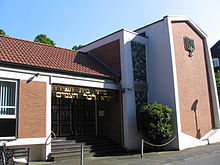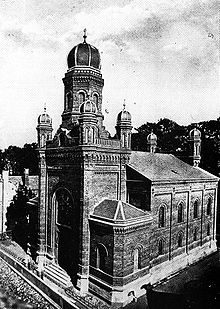Synagogue (Münster)
The Muenster Synagogue is a Jewish meeting place and place of worship for prayer , scripture study and instruction in Klosterstrasse on the promenade in Muenster . It is the successor to the old synagogue that was destroyed in the Night of the Reichspogrom and was inaugurated on March 12, 1961.
description
The building was designed by the architect Helmut Goldschmidt . The externally visible load-bearing elements are made of reinforced concrete, the outer walls are clinkered with red brick. The Star of David can be seen in the center of the gable facade facing the promenade, and the menorah on the opposite side . In addition to the prayer house, the building complex of the community center is divided, which are grouped around an inner courtyard with an adjacent garden area. There are the rabbinate, the community hall, classrooms, a caretaker's apartment and the mikveh . The synagogue offers space for around 100 people.
history
Old synagogue
The Jewish community built a representative synagogue in the Byzantine style on the same site in 1878–1880. The inauguration took place on August 28, 1880. During the Reichspogromnacht from November 9-10, 1938, SA men set fire to the synagogue. The fire brigade only intervened when the flying sparks threatened neighboring buildings such as the Raphaelsklinik. The city of Münster asked the Jewish community to remove the ruins at their own expense. The city bought the vacated property from the Jewish community at a ridiculous price of RM 28,000. Rabbi Fritz Leopold Steinthal emigrated to Argentina in 1938. From 1939, cover ditches against air raids and a fire water pond were built on the property. After 1945 some Jews returned to Westphalia , including Hugo Spiegel . The first Jewish service took place on September 7, 1945 in the still largely undamaged synagogue in Warendorf. In Münster the Jewish community mostly gathered in private rooms.
New synagogue
It was not until 1961 that the personnel and financial requirements for rebuilding the new synagogue on the old square were met. In its strongly structured rectangular body, it is intended to be reminiscent of the camp barracks at Auschwitz . Due to the large number of Jews who emigrated from Russia , the number of the community rose sharply in the early 1990s. Therefore, in 2012, for the first time, Efraim Yehoud-Desel was appointed a rabbi for the community and the synagogue was expanded according to the plans of the architect Natha Schächter . During the excavation work, the foundations of the old synagogue were found. On October 28, 2012, the annex was opened to the public in an “open door” ceremony.
In front of the new building there is a memorial plaque with the following inscription in capitals :
“Here was the church of the Jewish community in our city of Münster. - On November 9, 1938, she became a victim of racial madness. Of the congregation, which in 1938 still had 430 members, only 20 survived. The dead as an honorable memory, the living as a warning. November 9, 1948 "
In the Middle Ages there was a Jewish cemetery on the school grounds of today's Paulinum Grammar School . This was leveled after the persecution of the Jews at the time of the Black Death in 1350. The only surviving memorial stone from 1324 is in the synagogue of the Jewish community of Münster, after it was in the meantime at the newer Jewish cemetery . This is the oldest surviving Jewish tombstone in Westphalia.
literature
- Elfi Pracht-Jörns: Jewish cultural heritage in North Rhine-Westphalia . 4, Münster administrative district; (= Contributions to the architectural and art monuments of Westphalia; 1,2), Bachem, Cologne 2002, ISBN 3-7616-1397-0 , pp. 25–32.
- Karl Hagemann: Münster - city of churches: 70 houses of God and their communities in portrait . Aschendorff, Münster 1983, ISBN 3-402-05204-0 , pp. 146-147.
Individual evidence
- ↑ Westfälische Nachrichten : Surprising find during construction work on Klosterstrasse: Remains of the synagogue that was destroyed in 1938 discovered , Münster, November 5, 2011
- ↑ Dorstener Zeitung : “Like a small miracle”: Jewish community inaugurates new community hall ( memento of the original from August 7, 2016 in the Internet Archive ) Info: The archive link was inserted automatically and not yet checked. Please check the original and archive link according to the instructions and then remove this notice. , Münster, Stefan Bergmann, October 28, 2012
- ↑ a b c Westfälische Nachrichten : Graves under the Paulinum: the school grounds once housed the Jewish cemetery - students remember it , Münster, Karin Völker, February 6, 2015
- ↑ juedischer-friedhof-muenster.de: History of the Jewish cemetery on Einsteinstrasse , Marie-Theres Wacker, accessed on August 7, 2016
- ↑ juedischer-friedhof-muenster.de: Remembrance-cultural school project at the Paulinum grammar school in Münster: Memorial stone for the former Jewish cemetery , Thomas Deibert, Birgit Seggewiß, accessed on August 7, 2016
- ↑ "The Jewish Cemetery Culture " on www.gelsenzentrum.de.
Web links
Coordinates: 51 ° 57 ′ 33.7 " N , 7 ° 37 ′ 55" E





